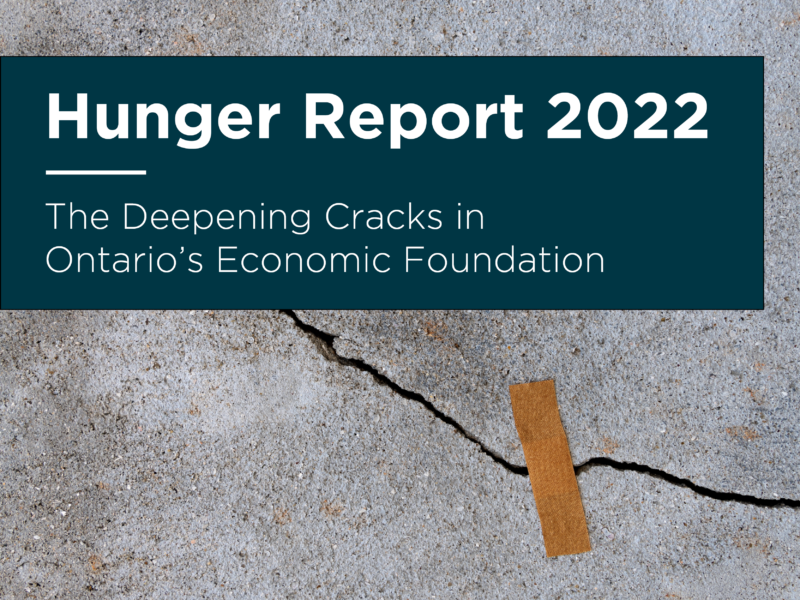Feed Ontario’s 2022 Hunger Report
The 2022 Hunger Report provides analysis of the data gathered by the Ontario food bank network through the Link2Feed client intake system between April 1st, 2021, and March 31st, 2022. This year’s report also includes a feature that explores why it is harder to escape poverty today than it was 30 years ago and how public policy decisions and insufficient investments in our social safety net have resulted in deepening cracks in our economic foundation.
Click the links below for more information on this year’s Hunger Report and how you can take action:
Key Highlights | Recommendations for Change | Take Action | Learn More

Key Report Highlights
Food bank use data
Food bank use remains at an all time high with this year marking the sixth consecutive year of food bank use increases.
- 587,103 adults and children accessed a food bank in Ontario between April 1st, 2021, to March 31st, 2022 – an increase of 15 percent over the last three years.
- Ontario’s food banks were visited more than 4,353,000 times throughout the year, an increase of 42% over the last three years.
- There has been a 47% increase in people with employment accessing food banks since 2018.
Additional food bank data shows that between January 2022 and September 2022:
- The number of people accessing a food bank increased by 24% over the previous year alone.
- First time visitors have increased 64% over pre-pandemic levels, with 1 in 3 visitors being those who had never turned to a food bank for assistance before.
- Ontario’s food banks were visited an average of 403,000 times per month, a 20% increase over the previous year and a 56% increase over the monthly average leading up to the pandemic.
Longstanding drivers of food bank use
In addition to unprecedented inflation rates, and the rise in cost of living, there are several longstanding income insecurity issues and poor public policies that have contributed to the rise in food bank use.
- Precarious employment – In the two years leading up to the pandemic, the number of people with employment turning to food banks for assistance increased by 27% and an additional 16% between 2020 – 2022. In fact, almost 1 in 10 of those employed in Ontario are gig workers.
- Inaccessible employment supports – Changes to Employment Insurance over the past 40 years are making it less accessible, leaving a mere 27% of unemployed Ontarians eligible to receive EI benefits in 2019.
- Inadequate disability supports – 2 out of 3 people who access food banks are social assistance recipients with 32.5% citing ODSP (Ontario Disability Support Program) and 26% citing OW (Ontario Works) as their primary source of income.
- Disinvestment in social housing – 70% of food bank visitors spend 68% or more of their monthly income on rent. Yet to be considered affordable, housing costs should not exceed 30% of a household’s total monthly income.
General statistics
- When asked the reason for visiting a food bank, 45.8% cited cost of food, 13.2% cited cost of housing, and 9.9% cited low wages or not enough work hours.
- Food banks are working to meet the growing demand, however, there is a concern that the need in the province may outpace the capacity of the provincial food bank network. A recent survey of 140 food banks revealed that:
- 2 out of 3 food banks have experienced a noticeable decrease in food donations.
- 1 in 5 food banks have not been able to purchase the same volume of food due to higher food prices.
Recommendations for Change
In many ways, food banks are like the paramedics of social support. They are there to respond to emergencies and provide immediate help during times of crisis, but are not designed or intended to cure ongoing needs. It is only through strong public policies that we can ensure every Ontarian has sufficient income to afford a basic standard of living.
While there are not shortage of ways that the Government of Ontario can improve income security and affordability in our province, Feed Ontario would like to put forward the following recommendations as immediate first steps that can be taken to improve the health and well-being of Ontarians and decrease the need for food banks:
- Provide gig workers with the same employment protections as other sectors.
- Close the gap on poverty by increasing social assistance rates to a basic standard of living.
- Make affordable housing accessible so people don’t have to choose between paying the rent or buying food.
- Put people with lived experience at the centre of policy and program design.
Get Involved
You can help #FeedChange and support people in need across Ontario by sharing the findings of the 2022 Hunger Report and Feed Ontario’s recommendations for change!
How Can I Participate?
- Contact: Call, email, or visit your MPP
- Social Media: Post our shareables and tag us @FeedOntario so we can boost it, as well as your MPP.
Who Should I Contact?
Your Own MPP:
Visit this site to Find your MPP
Other Key MPPs:
Premier Doug Ford, @FordNation
Minister of Children, Community and Social Services, Merilee Fullerton @DrFullertonMPP
Parliamentary Assistant for Community and Social Services, Logan Kanapathi @LoganKanapathi or Nolan Quinn (Nolan.Quinn@pc.ola.org)
Minister of Labour, Training and Skills Development, Monte McNaughton @montemcnaughton
Minister of Municipal Affairs and Housing, Steve Clark @SteveClarkPC
Learn More
If you are interested in learning more about hunger and poverty in Ontario, please see below:
- Hunger in my Riding Tool
- Hunger Map
- Cost of Poverty
- Previous editions of Hunger Report
- Our Recommendations for Change
